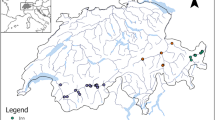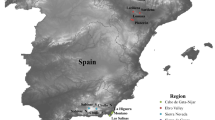Abstract
No definitive explanation for the form of the relationship between species diversity and ecosystem productivity exists nor is there agreement on the mechanisms linking diversity and productivity across scales. Here, we examine changes in the form of the diversity–productivity relationship within and across the plant communities at three observational scales: plots, alliances, and physiognomic vegetation types (PVTs). Vascular plant richness data are from 4,760 20 m2 vegetation field plots. Productivity estimates in grams carbon per square meter are from annual net primary productivity (ANPP) models. Analyses with generalized linear models confirm scale dependence in the species diversity–productivity relationship. At the plot focus, the observed diversity–productivity relationship was weak. When plot data were aggregated to a focus of vegetation alliances, a hump-shaped relationship was observed. Species turnover among plots cannot explain the observed hump-shaped relationship at the alliance focus because we used mean plot richness across plots as our index of species richness for alliances and PVTs. The sorting of alliances along the productivity gradient appears to follow regional patterns of moisture availability, with alliances that occupy dry environments occurring within the increasing phase of the hump-shaped pattern, alliances that occupy mesic to hydric environments occurring near the top or in the decreasing phase of the curve, and alliances that occupy the wettest environments having the fewest species and the highest ANPP. This pattern is consistent with the intermediate productivity theory but appears to be inconsistent with the predictions of water–energy theory.







Similar content being viewed by others
References
Abrams PA (1995) Monotonic or unimodal diversity–productivity gradient: what does competition theory predict? Ecology 76:2019–2027
Bailey RG, Avers PE, King T, McNab WH (1994) Ecoregions and subregions of the United States (map). USDA Forest Service; 1:7,500,000 with supplementary table of map unit descriptions. Washington DC
Barbour MG, Glenn-Lewin D, Loucks O (2000) Progress towards North American vegetation classification at physiognomic and floristic levels. In: White PS, Micina L, Lepš J (eds) Vegetation science in retrospect and perspective, Proceedings of the 41st IAVS symposium. Opulus, Grangärde, pp 111–114
Bond M, Chase JM (2002) Biodiversity and ecosystem functioning at local and regional spatial scales. Ecol Lett 5:467–470
Chapin FS, Zavaleta ES, Eviner VT, Naylor RL, Vitousek PM, Reynolds HL, Hooper DU, Lavorel S, Sala OE, Hobbie SE, Mack MC, Diaz S (2000) Consequences of changing biodiversity. Nature 405:234–242
Chase JM, Leibold MA (2002) Spatial scale dictates the productivity–biodiversity relationship. Nature 416:427–430
Cliff AD, Ord JK, (1981) Spatial processes models and applications. Pion Limited, London
Connell JH, Orias L (1964) The ecological regulation of species diversity. Am Nat 98:399–414
Cramer W, Kicklighter DW, Bondeau A, Moore A III, Churkina G, Nemry B, Ruimy A, Schloss AL (1999) Comparing global models of terrestrial net primary productivity (NPP): overview and key results. Global Change Biol 5:1–15
Crawley MJ (1993) GLIM for ecologists. Blackwell, Oxford
Curtis JT (1959) The vegetation of Wisconsin. University of Wisconsin Press, Madison
Daubenmire RF (1956) Climate as a determinant of vegetation in eastern Washington. Ecol Monogr 26:131–154
Grace JB (1999) The factors controlling species density in herbaceous plant communities: an assessment. Perspect Plant Ecol Evol Syst 2:1–28
Grace JB (2001) The roles of community biomass and species pools in the regulation of plant diversity. Oikos 92:193–207
Grime JP (1973a) Competitive exclusion in herbaceous vegetation. Nature 242:344–347
Grime JP (1973b) Control of species density in herbaceous vegetation. J Environ Manage 1:151–167
Gross KL, Willig MR, Gough L, Inouye R, Cox SB (2000) Patterns of species density and productivity at different spatial scales in herbaceous plant communities. Oikos 89:417–427
Grossman DH, Faber-Langendoen D, Weakley AS, Anderson M, Bourgeron P, Crawford R, Goodin K, Landaal S, Metzler K, Patterson K, Pyne M, Reid M, Sneddon L (1998) International classification of ecological communities: terrestrial vegetation of the United States, vol I, The National Vegetation Classification System: development, status, and applications. The Nature Conservancy, Arlington, Virginia, USA
Guo Q, Berry WL (1998) Species richness and biomass: dissection of the hump-shaped relationships. Ecology 79:2555–2559
Haining R (1990) Spatial data analysis in the social and environmental sciences. Cambridge University Press, Cambridge
Hawkins BA, Porter EE (2003) Does herbivore density depend on plant diversity? The case of California butterflies. Am Nat 161:40–49
Hawkins BA, Field R, Cornell HV, Currie DJ, Guégan J-F, Kaufman DM, Kerr JT, Mittelbach GG, Oberdorff T, O’Brien EM, Porter EE, Turner JRG (2003) Energy, water, and broad-scale geographic patterns of species richness. Ecology 84:3105–3117
Hector A, Schmid B (1999) Plant diversity and productivity experiments in European grasslands. Science 286:1123–1127
Huston MA (1997) Hidden treatments in ecological experiments: re-evaluating the ecosystem function of biodiversity. Oecologia 110:449–460
Intermountain Fire Science Lab (1996) Net primary productivity. Missoula, Montana, USA (web resource URL: http://www.icbemp.gov/spatial/crbsum/)
Jennings M, Faber-Langendoen D, Peet R, Loucks O, Glenn-Lewin D, Damman A, Barbour M, Pfister R, Grossman D, Roberts D, Tart D, Walker M, Talbot S, Walker J, Hartshorn G, Waggoner G, Abrams M, Hill A, Rejmanek M (2004) Guidelines for establishing and revising associations and alliances of the U.S. National Vegetation Classification: Version 4.0. Vegetation Classification Panel of the Ecological Society of America, Washington, (web resource URL: http://esa.org/vegweb/docFiles/NVC_Guidelines-v40.pdf)
Kaluzny SP, Vega SC, Cardoso TP, Shelly AA (1998) S+ spatial stats. Springer, Berlin Heidelberg New York
Kruskal JB (1964) Nonmetric multidimensional scaling: a numerical method. Psychometrika 29:115–129
Leibold MA (1999) Biodiversity and nutrient enrichment in pond plankton communities. Evol Ecol Res 1:73–95
McCullagh P, Nelder JA (1989) Generalized linear models. Chapman and Hall, New York
McCune B, Mefford MJ (1999) Multivariate analysis of ecological data, version 4.17. MjM Software, Gleneden Beach
Mitchell-Olds T, Shaw RG (1987) Regression analysis of natural selection: statistical influence and biological interpretation. Evolution 41:1149–1161
Mittelbach GG, Steiner CF, Scheiner S, Gross K, Reynolds HL, Waide R, Willig M, Dodson SI, and Gough L (2001) What is the observed relationship between species richness and productivity? Ecology 82(9):2381–2396
Naeem S (2002) Ecosystem consequences of biodiversity loss: the evolution of a paradigm. Ecology 83:1537–1552
NatureServe (2002) NatureServe Explorer: an online encyclopedia of life, Version 1.6. NatureServe, Arlington, Virginia, USA (web resource URL: http://www.natureserve.org/explorer)
Neter J, Kutner MH, Nachtsheim CJ, Wasserman W (1996) Applied linear statistical models, 4th edn. R.D. Irwin, Chicago
Nicholls AO (1989) How to make biological surveys go further with generalized linear models. Biol Conserv 50:51–75
O’Brien EM (1993) Climatic gradients in woody plant species richness: towards an explanation based on an analysis of southern Africa’s woody flora. J Biog 20:181–198
O’Brien EM (1998) Water-energy dynamics, climate, and prediction of woody plant species richness: an interim general model. J Biog 25:379–398
Oksanen J (1996) Is the humped relationship between species richness and biomass an artifact due to plot size? J Ecol 84:293–295
Preston FW (1962) Canonical distribution of commonness and rarity: part 1. Ecology 43:185–215
Rosenzweig ML (1995) Species diversity in space and time. Cambridge University Press, Cambridge
Running SW (1994) Testing forest-BCG ecosystem process simulations across a climate gradient in Oregon. Ecol Appl 4:238–274
Running SW, Hunt ER Jr (1993) Generalization of a forest ecosystem process model for other biomes, Biome-BGC, and an application for global-scale models. In: Ehleringer JR, Field C (eds) Scaling processes between leaf and landscape levels. Academic, London, pp 141–158
Scheiner SM, Jones S (2002) Diversity, productivity and scale in Wisconsin vegetation. Evol Ecol Res 4:1097–1117
Scheiner SM, Cox SB, Willig M, Mittelbach GG, Osenberg C, and Kaspari M (2000) Species richness-area curves and Simpson’s paradox. Evol Ecol Res 2:791–802
Schulze ED, Mooney HA (1993) Biodiversity and ecosystem function. Springer, Berlin Heidelberg New York
Sokal RR (1979) Testing statistical significance of geographic variation patterns. Syst Zool 28:627–632
Tilman D (2000) Causes, consequences and ethics of biodiversity. Nature 405:208–211
Tilman D, Lehman CL, Thomson KT (1997) Plant diversity and ecosystem productivity: theoretical considerations. Proc Natl Acad Sci USA 94:1857–1861
USDA NRCS (2000) The PLANTS database. National Plant Data Center, Baton Rouge, Louisiana, USA (web resource URL: http://plants.usda.gov)
VEMAP Members (1995) Vegetation/ecosystem modeling and analysis project (VEMAP): Comparing biogeography and biogeochemistry models in a continental-scale study of terrestrial ecosystem responses to climate change and CO2 doubling. Global Biogeochem Cycles 9:407–438
Venables WN, Ripley BB (2002) Modern applied statistics with S. Springer, Berlin Heidelberg New York
Vincent PJ, Haworth JM (1983) Poisson regression models of species abundance. J Biogeogr 10:153–160
Waide.B, Willing MR, Steiner CF, Mittelbach G, Gough L, Dodson SI, Juday GP, Parmenter R (1999) The relationship between productivity and species richness. Annu Rev Ecol Syst 30:257–300
White MA, Thornton PE, Running SW, Nemani RR (2000) Parameterization and sensitivity analysis of the BIOME–BGC terrestrial ecosystem model: net primary production controls. Earth Interact 4(3):1–85
Whittaker RH, Niering WA (1975) Vegetation of the Santa Catalina Mountains, Arizona. V. Biomass, production, and diversity along the elevation gradient. Ecology 56:771–790
Wright DH, Currie DJ, Maurer BA (1993) Energy supply and patterns of species richness on local and regional scales. In: Ricklefs RE Schulter D (eds) Species diversity in ecological communities: historical and geographical perspectives. University of Chicago Press, Chicago
Acknowledgements
We gratefully acknowledge Mike Austin, Sandy Andelman, Robert Waide and Frank Davis for their reviews and comments, and John Harris for geostatistical advice. This research was supported by the Knowledge Network for Biocomplexity project funded by the National Science Foundation’s Knowledge and Distributed Intelligence Program (NSF; Grant# DEB 99-80154), the National Center for Ecological Analysis and Synthesis, a Center funded by NSF (Grant#DEB-0072909), the University of California, and the Santa Barbara campus. Support was also provided by the U.S. Geological Survey.
Author information
Authors and Affiliations
Corresponding author
Additional information
Communicated by Jim Ehleringer
Rights and permissions
About this article
Cite this article
Jennings, M.D., Williams, J.W. & Stromberg, M.R. Diversity and productivity of plant communities across the Inland Northwest, USA. Oecologia 143, 607–618 (2005). https://doi.org/10.1007/s00442-005-0011-x
Received:
Accepted:
Published:
Issue Date:
DOI: https://doi.org/10.1007/s00442-005-0011-x




